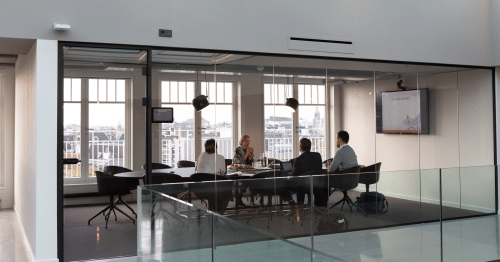The shift towards hybrid work has transformed the modern workplace, creating both new opportunities and challenges for businesses. Balancing the preferences of employees, who value flexibility, with the need to maintain collaboration, productivity, and culture, is no small feat.
As organizations continue to adapt to this evolving landscape, one of the most pressing questions is: how can businesses create a seamless hybrid work experience that supports everyone—whether they’re working from home or from the office? Let’s delve deeper!
The Future of Work: Trends and Smart Solutions
In recent years, the concept of work has been reshaped by the impact of technological advances, evolving employee expectations, and the global pandemic. These factors have pushed businesses to rethink traditional office setups and embrace more flexible work arrangements, leading to the rise of hybrid models.

Large – and middle size- companies, particularly in the tech industry, have been navigating this transition. While Apple faced challenges bringing employees back to the office, companies like Google have introduced a flexible hybrid model, allowing employees to split their time between home and office. Meanwhile, non-tech giants like Ford are also experimenting with hybrid work arrangements, recognizing the need to balance productivity with employee autonomy.
How Workplace Management Systems Support Hybrid Work
Workplace management systems (IWMS) are playing a critical role in this shift. These solutions simplify the complex logistics of hybrid work by offering tools for booking meeting rooms, managing office occupancy, and ensuring smooth transitions between remote and office work.
For facility and workplace managers, IWMS tools provide real-time insights into space usage and resource allocation, helping them make data-driven decisions. On the employee side, these systems enhance the work experience, making it easier to navigate hybrid schedules, find available desks, and collaborate with colleagues seamlessly—whether they are working from home or at the office.
Productivity in a Hybrid Model: Finding the Right Balance
Striking a balance between remote and office work isn’t just about where employees work—it’s about understanding how different environments impact productivity.
Studies have shown that employees working in an office environment can often experience higher levels of collaboration, creativity, and focus, especially when face-to-face interaction is necessary for certain tasks. For instance, a study by Harvard Business Review found that in-person interactions led to higher levels of innovation and productivity in complex projects Harvard Business Review.
On the other hand, hybrid work models have also proven to offer substantial benefits. Research from McKinsey & Company highlights that hybrid work increases employee satisfaction, improves work-life balance, and can even boost productivity, as employees have the flexibility to choose the environment that best suits their tasks McKinsey & Company.
During the webinar, we explore how businesses can maintain efficiency and employee satisfaction by leveraging hybrid work strategies.
Watch Our Webinar
Join Enitia Karijodinomo, Manager Partner Success at Spacewell, during this insightful webinar on balancing hybrid work. We cover future work trends, productivity strategies, and how smart building solutions can help create a thriving hybrid workplace. Here’s a quick look at the agenda:
- The Future of Work: Trends & Insights
- Workplace Productivity in a Hybrid Model
- Managing a Hybrid Workplace: Guidelines & Best Practices
- Workplace Wellness & Experience
- Real-Life Examples from the Market
- Q&A Session
Watch it now to gain actionable insights and strategies for navigating the complexities of hybrid work in your organization.











